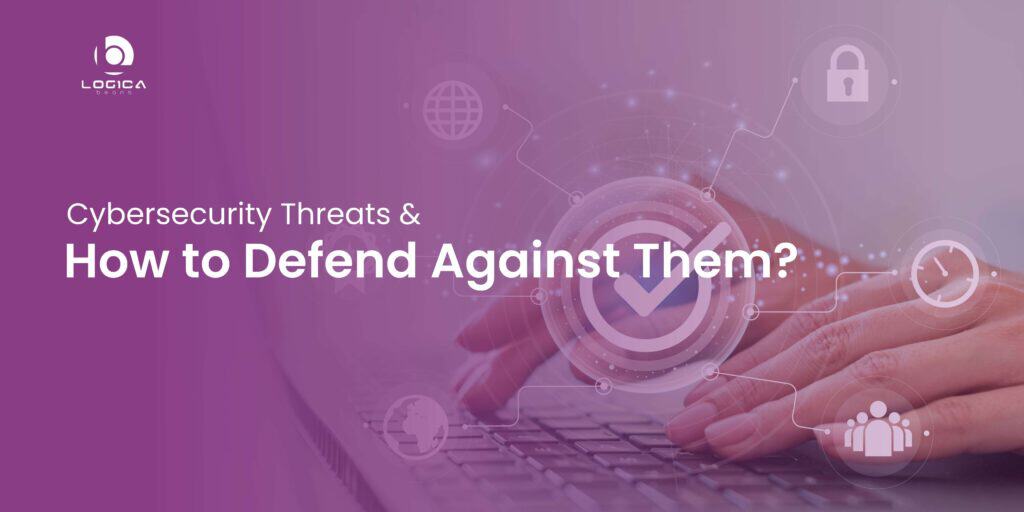This is a world where digital technologies dominate every part of our lives, and the possibility of cyber-attacks grows greater than ever. The fast advancement of technology has resulted in several benefits ranging from greater efficiency and communication to increased convenience and accessibility. However, the digital revolution has also given rise to a new generation of smart adversaries looking to exploit flaws in our networked networks.
The threat landscape has grown rapidly, with cybercriminals utilizing clever tactics to access networks, corrupt data, and wreak havoc on individuals, organizations, and governments alike. From data breaches and ransomware assaults to identity theft and nation-state hacking, the scope and complexity of cybersecurity threats are broad and ever-changing.
In this blog, we will talk about the growing environment of cybersecurity threats and the crucial need of protecting our digital assets.
Importance of cybersecurity in today’s digital world
Cybersecurity is significant in today’s digital environment for safeguarding the safety and privacy of our online activities. It’s all about protecting our sensitive information and data from frauds who are always looking for new methods to infiltrate our digital life. Consider the consequences if someone gained unauthorized access to our bank accounts, social media profiles, or personal emails.
One of the primary reasons for the importance of cybersecurity is that it helps safeguard our personal information from being stolen or exploited. Cybercriminals attack individuals and organizations with numerous strategies such as phishing emails, spyware, and ransomware in order to obtain our usernames, passwords, and financial information. We establish obstacles that make it far more difficult for these bad actors to succeed by deploying robust cybersecurity safeguards.
Cybersecurity is important not just for people, but also for companies and organizations. Businesses handle massive volumes of sensitive data, such as client information, trade secrets, and unique technologies. A cyber breach can result in financial losses, reputational harm, and consumer distrust. Businesses may preserve their data and maintain seamless operations by prioritizing cybersecurity, maintaining client trust and confidence.
Furthermore, cybersecurity is critical to national security. Governments and institutions control sensitive information and infrastructure that is important to a country’s operation. Cyberattacks from hostile governments or terrorist organizations can interrupt key services, compromise secret data, and endanger a country’s sovereignty. Strong cybersecurity measures aid in the prevention of such assaults and the defense against possible cyber warfare.
We rely on the internet in our everyday lives for shopping, banking, communication, and other purposes. To retain confidence in e-commerce and online transactions, cybersecurity is vital. When we buy anything online or give out our credit card information, we want to know that our information is safe. Cybersecurity fosters the growth of online companies and improves digital confidence among consumers by guaranteeing that online platforms are safe and trustworthy.
Overall, cybersecurity acts as a safeguard in the digital environment. It’s about remaining one step ahead of thieves, protecting our digital assets, and creating a safe environment in which individuals, organizations, and governments may prosper. We can enjoy the benefits of the internet and technology without worrying about the lurking hazards that might otherwise disturb our digital lives if we take cybersecurity seriously and apply best practices.
Understanding Cybersecurity Threats
Cybersecurity threats are a variety of harmful actions and assaults that target digital systems, networks, and data in order to cause harm, steal information, or disrupt operations. In today’s linked world, these dangers have become more frequent and complex.
Let’s look at some of the most typical sorts of cybersecurity threats:
● Malware
Malware (malicious software) refers to viruses, worms, Trojans, ransomware, and spyware. It has the ability to infiltrate computers and networks, jeopardising data integrity, stealing critical information, and demanding a ransom for data recovery.
● Phishing Attacks
Phishing is a social engineering method in which attackers send misleading emails or messages posing as trustworthy institutions in order to fool people into disclosing personal information such as passwords, credit card information, or login credentials.
● Denial-of-Service
DoS assaults seek to overwhelm a target’s resources, rendering services inaccessible to legitimate users. Attackers flood networks or systems with excessive traffic, creating interruptions.
● Advanced Persistent Threats
APTs are long-term targeted assaults carried out by competent opponents, who are frequently state-sponsored or organized criminal organizations. They enter networks quietly, remaining undiscovered for lengthy periods of time in order to take vital data.
● Insider Threats
Insider threats are persons within an organization who purposefully or inadvertently misuse their access for malevolent objectives. Employees, contractors, or partners having access to sensitive data may fall into this category.
● Ransomware
Ransomware encrypts the data of a victim, rendering it unavailable until a ransom is paid. It has evolved into a substantial threat to individuals and organizations, inflicting severe disruptions and financial losses.
● Supply Chain Attacks
Cybercriminals aim targeting the supply chain in order to corrupt software or hardware before it reaches end users. This enables them to widely spread harmful updates or altered items.
● State-Sponsored Cyberattacks
To acquire strategic advantages or disrupt opponents, governments and nation-states engage in cyber espionage, cyber warfare, and politically motivated cyberattacks.
Individuals, corporations, and governments must understand these cybersecurity dangers in order to take adequate security measures. A proactive strategy, which includes frequent software upgrades, personnel training, and stringent security standards, may help limit the dangers posed by these changing attacks and protect the digital environment.
Factors contributing to the rise of cybersecurity threats
The growth of cybersecurity threats may be linked to a mix of technology breakthroughs, societal shifts, and our digital world’s expanding interconnection.
Several factors contribute to the spread and sophistication of these threats, including:
● Growing Digital Footprint: As people and businesses become more reliant on digital technology, the amount of data created and stored online has grown tremendously. This increased digital footprint provides thieves with a bigger attack surface from which to target and exploit vulnerabilities.
● Increased Connectivity: The internet’s fast expansion and broad adoption of linked devices via the Internet of Things (IoT) have resulted in a highly interconnected ecology. While increased connectedness is convenient, it also creates new opportunities for cyberattacks as more gadgets become possible entry points.
● Cybercrime-as-a-Service: The rise of “cybercrime-as-a-service” has reduced the barrier to entry for cybercriminals. Malicious tools, ransomware kits, and hacking services are now accessible on the dark web for purchase, allowing even people with basic technical expertise to conduct cyberattacks.
● Advanced Attack strategies: Cybercriminals are constantly developing and refining their attack strategies. To circumvent typical security measures and avoid discovery, advanced hacking tools, zero-day exploits, and social engineering approaches are used.
● Inadequate security practices: Many people and organizations fail to apply strong security practices and upgrades, exposing their systems to known threats and vulnerabilities.
● Global nature of cybercrime: Cybercriminals may operate from anywhere in the globe, frequently breaching international borders and jurisdictional restrictions. This makes it difficult for law enforcement organizations to apprehend and prosecute cybercriminals.
Addressing the development of cybersecurity threats necessitates a multidimensional strategy that includes cybersecurity awareness and education, best practices implementation, and the use of modern security technology. Collaboration among governments, corporations, and individuals is essential for creating a more secure digital environment and protecting against an ever-changing cyber threat scenario.
How to defend against cybersecurity threats?
Defending against cybersecurity attacks necessitates a multi-layered, proactive strategy. Implementing a mix of technological measures, security best practices, and user awareness may dramatically improve your cyber security.
Here are some critical procedures to take in order to guard against cybersecurity threats:
● Update all software on a regular basis, including operating systems, antivirus programmes, web browsers, and apps. Patches to repair security flaws that hackers may exploit are frequently included in software upgrades.
● Use passwords that are secure and distinctive for all of your accounts. Avoid utilising information that is easily guessed, such as birthdates or popular terms. To keep track of complicated passwords, consider utilising a password manager.
● Wherever practical, utilise MFA to add an extra layer of protection by asking users to give additional verification beyond their password, such as a one-time code delivered to their phone.
● Implement the concept of least privilege, allowing users just the access necessary to complete their responsibilities. This decreases the likelihood of insider threats and lessens the impact of a hacked account.
● Cybersecurity is a team effort. Collaborate with colleagues in the sector, cybersecurity professionals, and government organizations to exchange threat intelligence and keep up to date on emerging threats.
Individuals and organizations may dramatically increase their defence against cybersecurity attacks by applying these procedures and maintaining a proactive cybersecurity posture. Cybersecurity is a never-ending process, and continual efforts to keep updated about the dynamic threat landscape are critical to maintaining a safe digital environment.
Conclusion
Cybersecurity is becoming an important component in today’s digital landscape. With the growing incidence of cyber threats, it is critical to take a proactive strategy to defend against prospective assaults. We can create a safer digital ecosystem by implementing robust security measures, raising cybersecurity awareness, and investing consistently in innovation. We can secure our data, defend our privacy, and maintain the proper operation of our digital infrastructure by working together. Accepting cybersecurity as a shared duty will lead to a more secure and resilient digital future.










